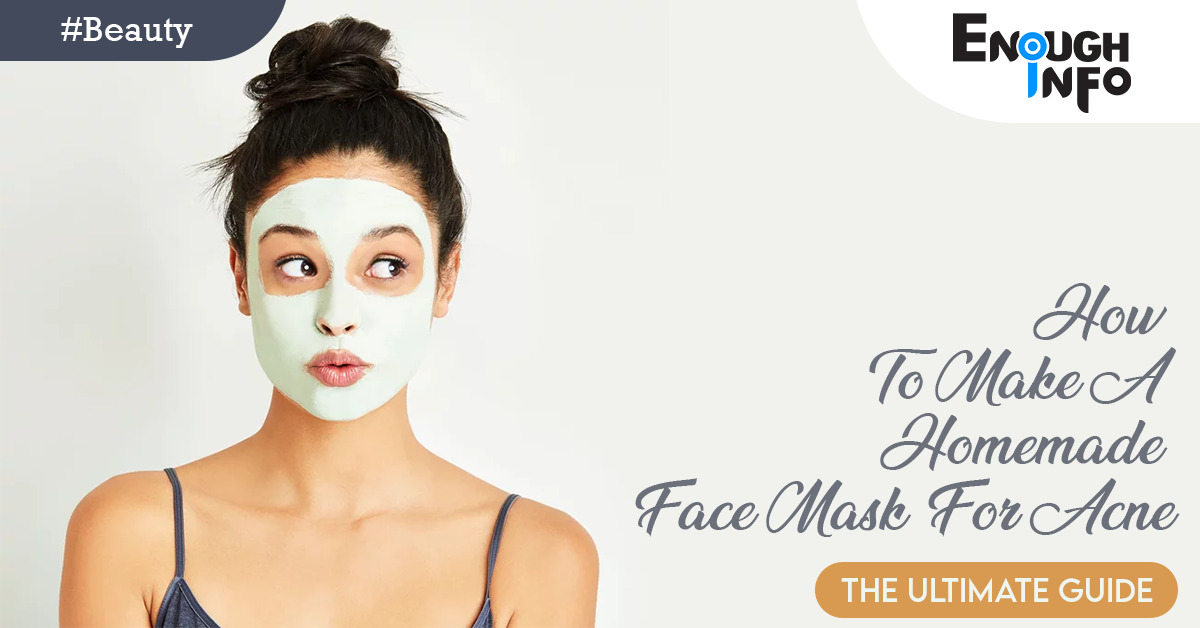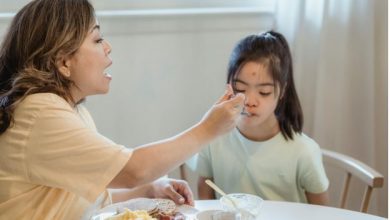How To Make A Homemade Face Mask For Acne

How To Make A Homemade Face Mask For Acne: Acne is a common skin condition that affects individuals of all ages and can be a source of frustration and self-consciousness. While there are numerous commercial products available to treat acne, many of them contain harsh chemicals that may cause dryness, irritation, or other adverse effects. If you’re looking for a natural and cost-effective solution, creating homemade face masks for acne can be a great alternative. EnoughInfo.com

Read Also: How to Get Rid Of Acne
What exactly is acne?
Acne vulgaris is a non-contagious, persistent, inflammatory skin disorder characterised by clogged hair follicles with oil (sebum) and dead skin cells. It is commonly related with hormonal fluctuations during adolescence.Acne can range from being somewhat minor to being quite severe. Oily skin is more prone to acne than dry skin. This has repercussions beyond the skin when it comes to people’s quality of life. How To Paint A Portrait With Acrylics(Step By Step)
FAQs & Answers on How to make a Homemade face mask for Acne
1. Are homemade face masks effective for all types of acne?
Homemade face masks can be effective for various types of acne, including whiteheads, blackheads, and mild inflammatory acne. However, if you have severe or persistent acne, it’s best to consult a dermatologist for professional advice and treatment options.
2. How often should I use homemade face masks for acne?
It is recommended to use homemade face masks for acne 1-2 times a week. Using them too frequently can overexfoliate or dry out your skin, so it’s important to give your skin time to rest and regenerate between applications.
3. Can I leave a homemade face mask on overnight?
No, it is not advisable to leave a homemade face mask on overnight. Most face masks, including homemade ones, are designed to be left on for a specific amount of time, usually 10-20 minutes. Leaving a mask on for too long can lead to skin irritation or excessive dryness.
Read Also: How To Make Homemade Natural Beauty Products
4. How long does it take to see results from homemade face masks for acne?
Results from using homemade face masks for acne can vary from person to person. It may take a few weeks of consistent use to notice visible improvements in your skin. Be patient and continue with a regular skincare routine for best results.
5. Can I store leftover homemade face masks for future use?
It is generally recommended to use homemade face masks immediately after preparation. Freshly made masks are more effective as they contain active ingredients at their peak potency. Storing them for an extended period may lead to a loss of effectiveness or potential bacterial growth. How To Paint A Portrait With Watercolor Pencils
6. Are there any side effects of using homemade face masks for acne?
Homemade face masks generally use natural ingredients, but individual reactions can vary. It’s important to perform a patch test before applying a mask to your entire face to check for any allergic reactions or skin sensitivities. If you experience any adverse effects, discontinue use and consult a dermatologist.
7. Can I use multiple homemade face masks in one session?
It is not recommended to use multiple face masks simultaneously, as it can lead to excessive drying or irritation. Stick to one mask at a time and give your skin time to rest and recover between applications.
8. Should I moisturize after using a homemade face mask?
Yes, it is essential to moisturize your skin after using a face mask, including homemade ones. Moisturizing helps restore hydration and balance to the skin, especially after exfoliating masks. Choose a moisturizer suitable for your skin type to keep your skin nourished and protected. How To Remove Stains From Carpet(The Ultimate Guide)
Acne classifications
Acne is classified into two types:
- Inflammatory acne – Comedo or blackheads and whitehead
- Non-inflammatory acne – Inflammatory papules, pustules, cysts, and nodules
What are the origins of acne?
Acne is caused by a variety of circumstances. Acne develops when the tiny skin pores become clogged with debris and oil.
Read Also: How To Make Homemade Face Moisturizer
Here are some acne-causing factors:
- Hormonal Factor
- Hereditary
- Diet
- Lack of exercise
- Stress
- a certain drug
- Smoking How To Potty Train A Toddler (The Ultimate Guide)
- Unsanitary skincare
What are acne’s signs and symptoms?
Acne symptoms vary according on the severity of your condition:
- Whiteheads (clogged, closed pores)
- Blackheads (clogged pores)
- Papules (little red, tender bumps)
- Pimples (pustules) are papules that have pus at their tips.
- Nodules are large, firm, painful lumps under the skin.
- Cystic lesions are painful, pus-filled tumours under the skin.
How do you treat acne?
When you have mild acne, you should initially try self-care solutions and other possibilities. The ideal treatment is to avoid sebum production, keep your face clean and bacteria-free, and encourage skin shedding to clear pores. Aside from that, acne therapy is solely reliant on the underlying cause.
Acne self-care treatment –
- Cleanse your skin on a regular basis with water and a nondrying soap.Scrubbing too vigorously may cause irritation.
- To keep your skin hydrated, moisturise it on a daily basis. Only use non-comedogenic, fragrance-free moisturiser.
- Drink enough of water to remove toxins from your system and keep you healthy.
- Do not repeatedly touch your face. How To Create A Budget For Retirement
- Never pick at your acne since it can lead to irritation, bleeding, and scarring.
Acne can be classified as mild, moderate, or severe. The treatment is determined on the severity and intensity of the condition –
Mild acne
Mild acne can be treated using over-the-counter (OTC) drugs such as gels and ointments. Here are some over-the-counter acne medications:
- Topical antibiotic ointments or gel – in mild acne, topical use may be sufficient to clear it. It contains benzoyl peroxide, salicylic acid, erythromycin gel, dapsone, and other ingredients.
- Retinoid – Retin-A, Adapalene, and Tazarotene are retinoids that are used to unclog pores through cell turnover.
These medications have the potential to cause skin irritation and burning. As a result, always use it at a low concentration.
Read Also: How To Do A Basic Skincare Routine
Acne ranging from moderate to severe –
If you are unable to control or avoid acne, it is always best to visit a dermatologist. There are several treatment options for moderate to severe acne.
- Oral anti-biotics: When you have inflamed, bloody acne, your dermatologist may prescribe antibiotics. Doctors frequently prescribe erythromycin and tetracycline to treat acne. Long-term usage of this medication may result in negative effects. Doxycycline, in instance, is a relatively safe medication with little side effects.
- Corticosteroid injections: This is the quickest technique to treat large, inflammatory pimples and cysts. A doctor may use diluted cortisone to treat this. How To Do Basic Car Maintenance For Women
- Oral contraceptive: Some oral contraceptive tablets have been demonstrated to be beneficial in treating acne. It can help ladies with acne by suppressing the hyperactive gland.
- Isotretinoin: This is an effective treatment for severe, inflammatory, scarring, and persistent acne. Isotretinoin is effective, however it has a number of significant adverse effects. As a result, numerous distinct controls are required before it is prescribed. This medication is taken for five to six months at the recommended dosage and has a high probability of preventing the recurrence of acne. Patients using this medication must avoid vitamin A since it can cause vitamin A toxicity. Dry lips, dry skin, nosebleed, and mood changes are all side effects.
- Phototherapy: Doctors can treat acne with ultraviolet (UV) light. Blue and red light therapy can eliminate microorganisms while causing no harm to the skin.
- Chemical peels: This entail applying chemicals such as salicylic acid, glycolic acid, or retinoic acid repeatedly. This is a minor acne treatment. Chemical peels are a low-cost, straightforward, and OPD-based therapy.
How to Make Homemade Face Masks for Acne: Natural Remedies for Clear and Healthy Skin

In this comprehensive guide, we will explore various effective ingredients and recipes to help you create your own acne-fighting masks at home. How To Start A Small Business From Home
Understanding Acne:
Before diving into the homemade face mask recipes, it’s important to understand the underlying causes of acne. Acne occurs when hair follicles become clogged with oil, dead skin cells, and bacteria, resulting in inflammation, redness, and breakouts. Hormonal imbalances, genetics, poor skincare habits, and lifestyle factors can contribute to the development of acne. By using natural ingredients in homemade face masks, you can address these factors and promote clearer and healthier skin.
Ingredients for Homemade Face Masks:
- Honey: Honey possesses natural antibacterial properties, making it an excellent ingredient for acne-prone skin. It helps fight bacteria, reduces inflammation, and soothes the skin. Look for raw, organic honey for maximum benefits.
- Cinnamon: Cinnamon not only adds a pleasant aroma to your face mask but also helps improve blood circulation, reduces inflammation, and fights bacteria that contribute to acne breakouts.
- Oatmeal: Oatmeal is known for its soothing properties and ability to gently exfoliate the skin. It helps remove dead skin cells, unclog pores, and absorb excess oil, making it a valuable ingredient for acne-prone skin.
- Yogurt: Yogurt contains lactic acid, which acts as a gentle exfoliator and helps promote a healthy complexion. It also has probiotics that can help balance the skin’s natural flora.
- Aloe Vera: Aloe vera has soothing and anti-inflammatory properties that can calm irritated skin. It also aids in healing and reducing redness associated with acne. How To Make Homemade Soap
- Tea Tree Oil: Tea tree oil is a potent natural antiseptic that helps fight bacteria and reduce acne breakouts. It should be used sparingly and diluted with a carrier oil or other ingredients.
Read Also: How To Make A DIY Face Mask For Oily Skin
Homemade Face Mask Recipes:
-
Honey and Cinnamon Mask:
Ingredients:
- 1 tablespoon of raw honey
- ½ teaspoon of cinnamon powder
Instructions:
- In a small bowl, mix the honey and cinnamon until well blended.
- Apply the mixture to your cleansed face, focusing on acne-prone areas.
- Leave the mask on for 10-15 minutes.
- Rinse off with lukewarm water and pat your skin dry.
- Apply a gentle moisturizer suitable for acne-prone skin.
2. Oatmeal and Yogurt Mask:
Ingredients:
- 2 tablespoons of ground oatmeal
- 2 tablespoons of plain yogurt
Instructions:
- Grind the oatmeal in a blender or food processor until it becomes a fine powder.
- In a bowl, mix the ground oatmeal with yogurt until you achieve a smooth consistency.
- Apply the mixture to your face, avoiding the eye area.
- Allow the mask to sit for 15-20 minutes.
- Rinse off with warm water and pat your skin dry.
- Follow up with a lightweight, oil-free moisturizer.
3. Aloe Vera and Tea Tree Oil Mask:
Ingredients:
- 2 tablespoons of freshly extracted aloe vera gel
- 3-4 drops of tea tree oil
Instructions:
- In a small bowl, combine the freshly extracted aloe vera gel and tea tree oil. 2. Stir the mixture well to ensure the oil is evenly distributed.
- Apply the mask to your cleansed face, focusing on problem areas.
- Allow it to dry for 15-20 minutes.
- Rinse off with cool water and gently pat your skin dry.
- Finish with a non-comedogenic moisturizer suitable for your skin type.
4. Turmeric and Yogurt Mask:
Ingredients:
- 1 teaspoon of turmeric powder
- 2 tablespoons of plain yogurt
Instructions:
- In a bowl, mix the turmeric powder and yogurt until well combined.
- Apply the mixture evenly to your face, avoiding the eye area.
- Leave the mask on for 15-20 minutes.
- Rinse off with lukewarm water, gently massaging your skin in circular motions to exfoliate.
- Pat your skin dry and follow up with a moisturizer.
5. Green Tea and Lemon Mask:
Ingredients:
- 1 green tea bag
- 1 tablespoon of freshly squeezed lemon juice
- 1 teaspoon of honey (optional)
Instructions:
- Brew a cup of green tea by steeping the tea bag in hot water for a few minutes.
- Allow the tea to cool down completely.
- In a bowl, combine the cooled green tea with freshly squeezed lemon juice.
- If desired, add honey to the mixture and mix well.
- Apply the mask to your face using a cotton pad or your fingers.
- Leave it on for 10-15 minutes.
- Rinse off with cool water and pat your skin dry.
- Apply a lightweight moisturizer.
Tips for Using Homemade Face Masks:
- Patch Test: Before applying any homemade face mask to your entire face, perform a patch test on a small area of your skin to check for any adverse reactions or allergies.
- Cleanse your Face: Wash your face with a gentle cleanser before applying a face mask. This ensures that your skin is free of dirt, oil, and makeup, allowing the mask to penetrate better.
- Avoid Sensitive Areas: When applying a face mask, avoid the delicate skin around your eyes and lips. These areas are more sensitive and can be easily irritated. How To Create A Budget For Saving Money
- Frequency: Use these homemade face masks 1-2 times a week to avoid overexfoliating or drying out your skin. Consistency is key in achieving results.
- Moisturize: After rinsing off the mask, apply a moisturizer suitable for your skin type to keep your skin hydrated and balanced.
- Sun Protection: It is crucial to wear sunscreen daily, even if you’re using homemade face masks. Some ingredients may increase your skin’s sensitivity to the sun, so protect your skin with SPF to prevent further damage.
Read Also: How To Make A DIY Face Mask For Glowing Skin
Conclusion:
Creating homemade face masks for acne allows you to take control of your skincare routine and use natural ingredients to address your specific skin concerns. The recipes mentioned in this article harness the power of ingredients like honey, cinnamon, oatmeal, yogurt, aloe vera, tea tree oil, turmeric, green tea, and lemon to combat acne, reduce inflammation, fight bacteria, exfoliate gently, and promote clearer, healthier skin.
Remember, everyone’s skin is unique, and what works for one person may not work for another. It’s essential to listen to your skin, observe how it responds to different ingredients, and make adjustments as needed. If you have severe or persistent acne, it’s advisable to consult a dermatologist for personalized advice and treatment options.
With patience, consistency, and a commitment to a healthy skincare routine, you can achieve clearer and healthier skin using these homemade face masks.
Recommended;
23 Best Ways To Remove Blackheads(All You Need Know)
How To Be A Clean Person (10 Great Ways)
How To Clean A Derma Roller(Step by Step)




